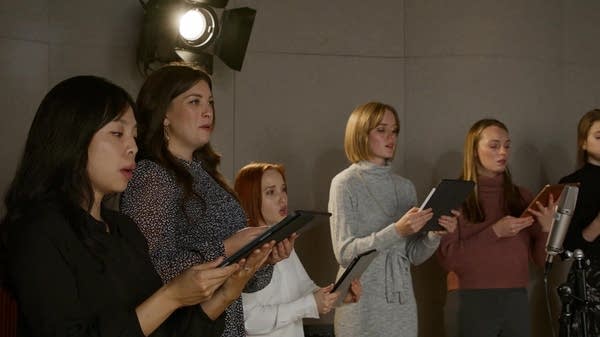Audio note: The Mosaic United Methodist Church Choir sings "Love Divine" from an 1833 collection, as part of the American Classical Hymns project.
Peter Mercer-Taylor offered up a strong contender for Understatement of the Year:
"These are strange times to be doing choral performances."
That hasn't deterred Mercer-Taylor even a little bit from seeking out choirs across the land to contribute performances to his website, AmericanClassicalHymns.com. The goal: to amass 278 hymn tunes that can accompany and amplify — indeed, literally bring to life — his just-published book, Gems of Exquisite Beauty: How Hymnody Carried Classical Music to America ($55, Oxford University Press).

The University of Minnesota music professor's magnum opus explores how sacred lyrics (hymns) came to be accompanied by classical-music compositions (hymn tunes) throughout the United States from 1819 to 1860. As the book's subtitle notes, this widespread practice provided many Americans' first exposure to European classical composers. In a real sense, the kind of "discovery" our ancestors experienced two centuries ago is mirrored in these new renditions, especially with the pandemic preventing virtually any personal exposure to live performances.
"This is a surprisingly helpful and relevant repertoire in the COVID era," he said. "We're living through a stretch of history when a lot of classical-music venues are shuttered, and choirs themselves can't do all the things they'd like to do. But they can still sing these hymn tunes.
"[The original] tunes gave glimpses of classical music to an American public that didn't really have a developed classical-music culture, and [the website's recordings] stand to give glimpses of classical music today to an American public living with a drastically reduced classical-music culture."
As of this writing, 23 tunes are available at the website, with several more in the works. Mercer-Taylor classified the current crop as "a priming of the pump" and has issued an open call for more contributions. Those interested can find out more on the website or contact Mercer-Taylor directly at ach@umn.edu.
The coronavirus has slowed the rate of contributions since Mercer-Taylor began to amass them after completing the book in February. Still, during these admittedly "strange times," he said two recording formats remain, well, in play.
The "synchronous" approach is closest to the pre-COVID method: a socially distant performance with probably no more than 12 singers spread out in one room. For many choirs, that's a fraction of the usual assemblage, but the Ball State University Chamber Choir, among others, has made it work.
And that's "kind of the easy way," Mercer-Taylor noted, compared with the "asynchronous remote recording." In that process, he said, "you usually have the piano player get the hymn tune and play a four-part [rendition, with soprano, alto, tenor and bass], which is then sent to individuals. They listen on headphones and record individual performances, then send those tracks to some kind of master compiler, who creates a composite."
While pop musicians are accustomed to recording this way, it's a challenge for choral singers.
"It's laborious to [coalesce in] matters of expression, louder or softer, faster or slower," Mercer-Taylor said, "whereas when they're in the same room, there's all kinds of things a choir can do to take cues."
Still, technology allows for the likes of Paul Damico-Carper to create what Mercer-Taylor aptly calls "deeply sensitive renditions of three tunes in which he sings all four parts himself."

The final group renditions, thanks to the work of technical wizards, might end up a capella or accompanied by Tim Lovelace's original piano work. The completed recordings have their own pages — accessible via a showcase catalog at the website, complete with photos of the performers and the actual musical score.
All of which fits the words of Robert Frost:
'Men work together,' I told him from the heart,
'Whether they work together or apart.'
The collection so far has emanated from ensembles with which Mercer-Taylor had had a personal connection, via former students of his and current or former colleagues.
Among those was the Twin Cities-based Mirandola Ensemble, whose rendition of Joseph Haydn's "Belchertown" is one of Mercer-Taylor's favorites ("incredibly persuasive … beautiful, shapely").
Mirandola artistic director Nicholas Chalmers said that this hymn tune, one of four recorded by his cohorts at Minneapolis' Annunciation Catholic Church, was a perfect fit.
"It's adapted from a string quartet, and we kind of think of ourselves that way," he said. "The music is relatively straightforward, but it has a great amount of elegance and dignity."
Chalmers added that he and his mates are highly motivated to nail the hymn tunes, partly because they're a good fit but mostly because of the nature of the works.
"A lot of what we do is music that doesn't get performed anymore," he said. "We do a lot of medieval music, so this was actually far newer.
"We always like it when the performance has elements of musicology. And anytime you're unearthing music that has been lost or underperformed, that's a noble effort."
Love the music?
Show your support by making a gift to YourClassical.
Each day, we’re here for you with thoughtful streams that set the tone for your day – not to mention the stories and programs that inspire you to new discovery and help you explore the music you love.
YourClassical is available for free, because we are listener-supported public media. Take a moment to make your gift today.
Your Donation

This activity is made possible in part by the Minnesota Legacy Amendment‘s Arts & Cultural Heritage Fund.










